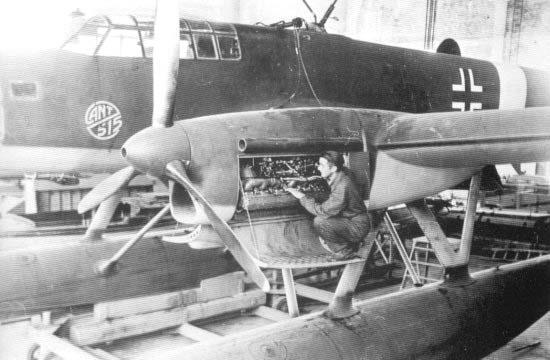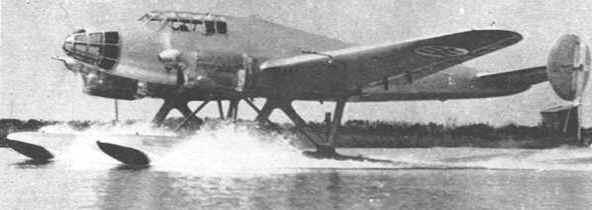The Z.515 (Z denoting a Zappata design) was the result of a requirement for a reconnaissance seaplane with light bombing capability. It was smaller and lighter than the established CANT Z.506 reconnaissance bomber, which was a three engine aircraft.
The Z.515 was a cantilever low wing monoplane with straight tapered wings of noticeable dihedral and rounded tips. There were flaps inboard of the ailerons. Twin 560 kW (750 hp) V-12 Isotta-Fraschini Delta engines were mounted well forward of the leading edge with their thrust line in the wing plane. The fairings behind engine mountings on the wing underside extended aft to near the trailing edge; the rear engine mounting also supported the forward attachment points for the rearward sloping, N-form struts to the two long, single stepped floats. The floats were laterally braced by inverted-V struts to the bottom of the fuselage. The Z.515's tailplane was mounted on top of the fuselage with greater dihedral than the wing and carrying endplate fins. The horizontal surfaces were straight tapered and the elevators, like the rudders had trim tabs. The vertical surfaces were almost elliptical, split roughly equally between fin and unbalanced rudder.
The lower nose of the Z.15 was completely glazed, with the long cockpit largely forward of the wing leading edge. There was a low dorsal machine gun turret at mid-chord and three further lower calibre machine guns. Up to 600 kg (1,320 lb) of bombs could be carried.
The CANT Z.515 first flew in 1939 but was not developed further Some sources suggest a first flight date of 8 July 1940, a significant initial order, later cancelled, and a possible pre-production run of some 10-15 aircraft but the details, including the number completed, are uncertain. At least one had German markings. The R. S. 14 proved to be a disappointing machine and the Regia Aeronautica reconsidered construction of a series of 515 and a first order of 15 planes was assigned to the CRDA in early 1942. The first series machine flew Oct. 7, 1942, while the second was to be ready on 8 September 1943. After the CRDA passed under the German administration, they were authorized to the complete the series. Another 7 seaplanes were completed by March 1944, when three of the RAF bombing raids (March 19, 4, :20 April) completely destroyed the Officine Aeronautical and aircraft under construction
| Type |
Reconnaissance sea plane |
| Engine |
2 × Isotta-Fraschini Delta R.C.40 with 3-bladed propellers |
| Dimensions |
Length 16,04 m, height 5,86 m, span 22,50 m, wing area 63,10 m2 |
| Weights |
Empty 8482 kg, loaded , max. take off weight |
| Performance |
Max speed: 383 km/h, cruising speed 306 km/h, range 1770 km |
| Armament |
1 × 12.7 mm machine gun in rotating dorsal turret; 3 × 7.7 mm hand controlled machine guns Bombs: 600 kg |
| Type |
Werk.Nr |
Registration |
History |
|
|
|
|

